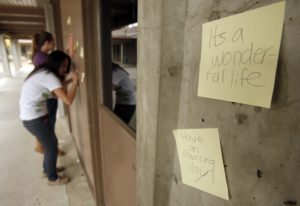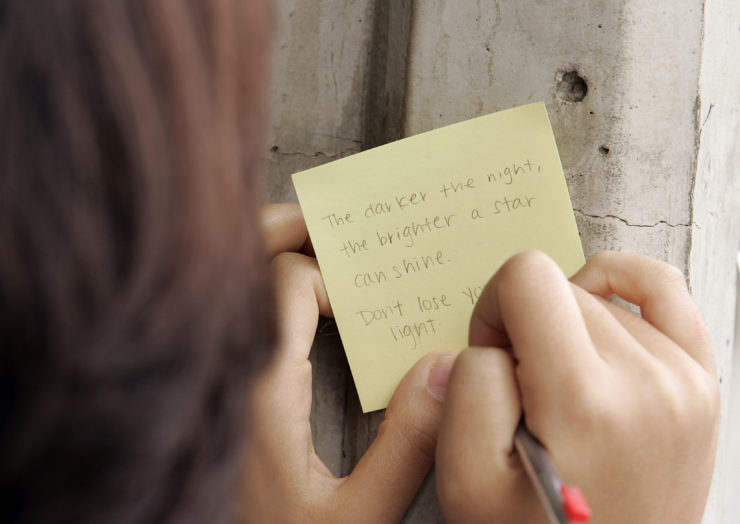Tomorrow’s journalists exploring the masters of today
Jacqui Banaszynski is a Pulitzer Prize-winning journalist who now is an endowed Knight Chair professor at the Missouri School of Journalism. Last semester, her Advanced Writing students at Missouri chose stories they liked and gave them the Storyboard treatment. We’re pleased to post their efforts.
As a young journalist interested in doing in-depth stories, I’m always on the lookout for articles that can help teach me the craft of reporting and writing. But I’ve also watched people I love struggle with mental illness; I’m often at loss to understand its causes, or how best to respond.
So I was especially drawn “The Silicon Valley Suicides,” Hanna Rosin’s immersive piece in the December 2015 issue of The Atlantic.
The story zeroes in on Palo Alto, Calif., weaving chilling narratives from siblings and parents of students who have killed themselves with commentary and context from expert sources. It attempts to balance a discussion of the intense pressure high school students face with this question: Under the same pressure, why does one child of privilege commit suicide and another does not?
When Rosin started her extensive reporting on the Silicon Valley suicides, residents of Palo Alto feared their community struggles would be sensationalized. They were also anxious about the timing: By the time the story was published, it was almost the one-year anniversary of the suicide of Cameron Lee, a popular high school athlete. They were concerned that it would reopen old wounds for the students in the community.

Rosin, a co-host of the Invisibilia podcast for NPR and contributing editor at The Atlantic, says her and her editors discussed this timing, but didn’t have another option. There was no other issue for the story to run in, and it was getting too far away from the time she spent in Palo Alto.
Since the article ran, Rosin has heard from schools in Illinois, California, New Jersey and Massachusetts saying they have changed curriculum or added parent forums to discuss related issues.
Rosin spoke with me by phone to discuss her desires, feelings and concerns for this story.
What made you want to write this story?
I had written a story called the “Overprotective Kid,” that was published in The Atlantic in April of 2014, which was about younger kids, and I guess I felt like this was a follow-up or stood as a Part Two to that story. I had actually been reading research about inequality and found that there were highly wealthy kids who had just as high rates of depression and anxiety as much poorer kids. It just seemed like an odd anomaly, because you think of rich kids being better-off in most parts. It’s just surprising that you would have equal rates of anxiety in richer kids, so you wonder where that is coming from. They just do better on all sorts of measures, and increasingly so in America. Then when I was talking to one of the researchers, we got to talking about Silicon Valley and it turned out that they were just in the middle of their second suicide and I wanted to explore that. Was it connected? Could you connect suicide to something like that?
I don’t really see the need to keep your emotions in check when you’re a reporter. I don’t consider that a goal. I mean, you feel what you feel when you’re talking to people. You don’t want to make people cry or make it about you, but certainly I’ve cried in many periods of my life.
You talk in the story about how teachers had to find the balance between discussing Cameron Lee’s death – not insulting his memory but not romanticizing his death. Were you ever worried about balancing that in your article?
Yeah, this is an area that is actually well explored and documented. Unlike most areas that one writes about, when writing about suicide there are things the protocol asks you not to do, and that is actually well researched, so I was thinking about that constantly. I’m sure I didn’t get it exactly right, but one of the things is to include extensive interviews with someone who attempted suicide but who lived. That kind of serves as the model for people that there is life after this kind of flood of thought that people have about suicide. And then the harder balance is, do you mention, for example, if there were suicide notes but don’t quote from them or have specific details from them, you know, stuff like that? There are kind of a lot of details about glamorizing and romanticizing that you try to avoid.
There were multiple moments in the story that gave me chills. Specifically when you wrote that a student told you the train warning whistle (on the day Camera Lee died) reminded her of “The Hunger Games” cannon, and when Taylor Chiu admitted that if she had known about students jumping in front of the train, she wondered if that would have seemed like a good idea to her on a really bad day. Was it hard for you as a reporter and a mother to keep your emotions in check with this story?
I don’t really see the need to keep your emotions in check when you’re a reporter. I don’t consider that a goal. I mean, you feel what you feel when you’re talking to people. You don’t want to make people cry or make it about you, but certainly I’ve cried in many periods of my life. Many parents I talked to are exactly in my situation. I have a high school-aged kid and younger kids, too. I think that the thing isn’t how I feel but being super-duper careful. They [the parents] are my age. They have kids, so a lot of this was just knowing who to approach and how to approach them and to do it delicately. There were some people I didn’t approach on the first trip at all, but then I saw them speak somewhere. For other people, I asked a friend of a friend or I wrote a letter and didn’t approach until my last visit. Every parent has a totally different situation. I didn’t approach the parents at all whose kids who had recently killed themselves, so what I did was ask their friends. Like for Cameron’s family, I tried contacting them saying [the article] was being written, but I had a friend of theirs get in touch with them and they agreed to do the fact-checking. But I did not sit down or have an interview with them, because it’s just too mean.
Did you receive any backlash after from the Palo Alto community?
Tons of backlash. The Atlantic does a forum afterward in the notes section where you can get a pretty good flavor of it, but there was a huge debate that had sparked, particularly in that community, and it went every which way. A sister of one of the guys that killed himself said, “Thank you, this is finally a discussion we needed to have.” Other people were like, “How dare you come in and blame school pressure for this? Suicide is very complicated. You can’t blame it on school pressure.” The superintendent was very unhappy with the story coming out on the anniversary and reminding people and drawing light to the issue to which they felt they had largely gotten over by then. So, yes, there’s tons of criticism.
Did writing this story change your mindset at all about suicide or the pressure put on students today?
Those are two separate questions. There are two sets of literature; one is about pressure, depression and anxiety. The other set of literature is about suicide, and I read those and feel no closer to understanding why, given a set of kids under pressure, why one kid will commit suicide and the other won’t. I think that’s not very well understood. There are things about suicide people understand, but I don’t think the decision in someone’s head and why one person makes it and the other one doesn’t, apart from they’re depressed, is that well understood. I certainly didn’t feel comfortable drawing a link saying pressure is what causes kids to commit suicide.
A sister of one of the guys that killed himself said, “Thank you, this is finally a discussion we needed to have.” Other people were like, “How dare you come in and blame school pressure for this? Suicide is very complicated. You can’t blame it on school pressure.”
But the separate question of pressure, yeah I did. I feel like it just seems unnecessary. Yes, I did ultimately conclude that high school was a little too – I wouldn’t say pressured; it’s not just about pressure It’s just that race to nowhere. It’s that kind of race-to-the-college problem. It’s just constructing high school so that it’s entirely a competition for what colleges desire. It just seems like a pointless kind of loop. It’s good to have high standards and hard work; it’s just that it’s constructed in a way to meet certain college requirements. You’re doing this so you can do more of it in college. I think it’s pretty common in high school education. I think most good schools in affluent neighborhoods are like this. It’s not just Silicon Valley. I think the difference in Silicon Valley is that the standards for success have gotten a little distorted, like what people consider success is pretty out of measure with what is actually success.
Katie Johns graduated from the University of Missouri in May 2016 with a dual degree in magazine journalism and Spanish. She is now a reporter for The Longboat Observer in Sarasota, Fla. A Chicago area native, she’s been soaking up the sun and wondering what January is like in warm weather.



